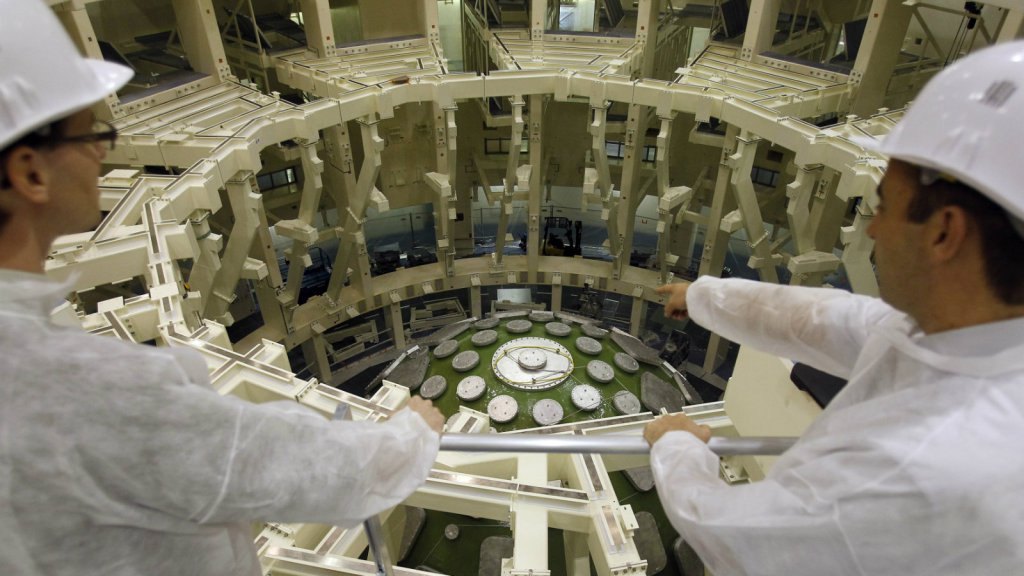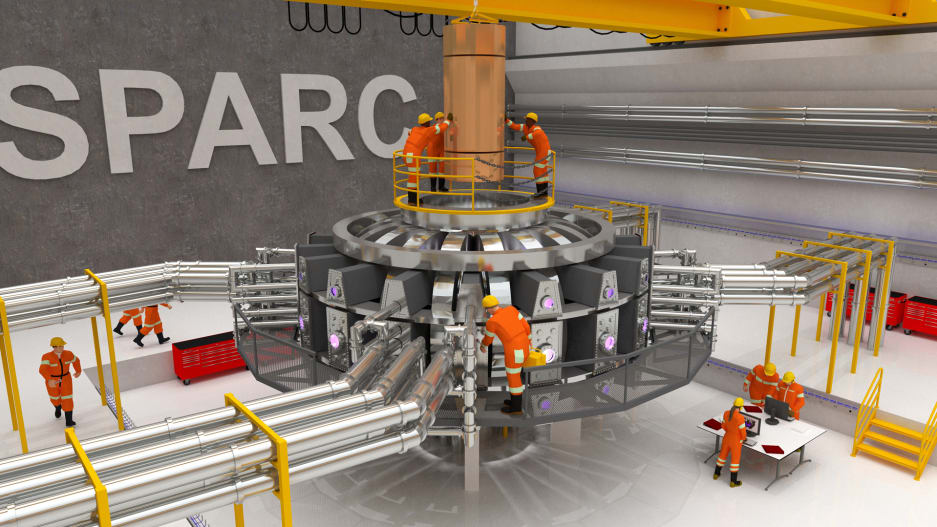
Date: 2025-12-13 Page is: DBtxt003.php txt00014849
Power
Nuclear Fusion
STAR POWER ... progress on Nuclear Fusion for power generation // BY ADELE PETERS ... This MIT Project Says Nuclear Fusion Is 15 Years Away (No, Really, This Time)
Burgess COMMENTARY
Now this is exciting. One of my friends from Cambridge University worked on a British nuclear fusion initiative back in the 1960s shortly after we left college. The project ended in failure, but the possibility that nuclear fusion can be harnessed to produce power for our modern world remains incredibly exciting. The British experiments showed that the fusion part would work, but they could not keep the system stable for more than a few microseconds .. and that just was not long enough!
Peter Burgess
STAR POWER

REUTERS/Regis Duvignau
MIT just had a nuclear fusion breakthrough. Since the 1950s, we’ve been hearing that fusion was just 20 years away. But there is something genuinely novel about a collaboration project between MIT and a private company, Commonwealth Fusion Systems.
The team is using a new, relatively cheap material to make extra-strong magnets — a crucial part of fusion reactors. The head of the fusion company involved told the Guardian that he could “put carbon-free fusion power on the grid in 15 years.”
An academic asked to weigh in on this timeline said it wouldn’t be quite that fast.
Fusion mashes atoms together at ridiculously high heat and pressure until they transform into different elements, releasing huge amounts of energy — the same process occurring at the center of the sun. It’s hot enough to melt anything it touches, so it has to be held together by magnets. The goal is essentially to hold a star within an electromagnetic vise.
The next step in the project will be an experimental reactor designed to flash on in 10 second bursts, with the goal of producing enough power each time to electrify a small city.
Nathanael Johnson
Mar 9, 2018
----------------------------------------------------------------------------
WORLD CHANGING IDEAS
BY ADELE PETERS ... This MIT Project Says Nuclear Fusion Is 15 Years Away (No, Really, This Time)
March 9, 2018
Fusion energy is clean, safe, and so far impossible to generate in any meaningful way. But a new startup is making another attempt to make it work–but as usual with fusion promises, it’s still at least a decade away from working.

This MIT Project Says Nuclear Fusion Is 15 Years Away (No, Really, This Time)
[Image: Ken Filar, PSFC Research Affiliate]
In the 1950s, researchers predicted that the world would have nuclear fusion–which uses hydrogen atoms, an incredibly abundant fuel, to provide clean, almost limitless power, while avoiding the hazardous waste problem and catastrophic risk of current nuclear power–within 20 years. By the 1970s, predictions were still at least that far away; the same was true by the 1990s. Now a team at MIT, along with an MIT spin-off company, Commonwealth Fusion Systems, says that the technology might finally be within reach.
Despite years of false starts, the university and startup believe that they can produce a working pilot plant in 15 years. A difference from the past, they say, is a new type of superconducting material that only recently became commercially available.
Nuclear fusion is, as evidenced by the speed of progress to date, an incredibly challenging problem. To slam hydrogen atoms together in a power plant to form helium–the same process that happens in the sun, but without the sun’s huge size and gravity–requires temperatures of 150 million degrees, so hot that it would turn any container into plasma. To make it work, researchers use magnetic fields to constrain the high-temperature gases. That has been proven to work, but it takes more energy to run the immensely powerful magnets than the generators produce. The real problem today is reversing that equation. Currently, ITER, a multinational fusion project, is facing severe cuts in the Trump administration budget, joining several other once-promising projects that haven’t lived up to their initial hype.
The team at Commonwealth and MIT plans to spend the next three years using the new superconducting material, a steel tape coated with a compound called yttrium-barium-copper oxide, to make new magnets that could be used to make net power output possible and commercially viable. This should be feasible, they say, because magnets that are even stronger have been built using the same material for other purposes. Then the team plans to build a device that can use the magnets, with a design based on decades of research at MIT and elsewhere.
“This is still a long timeline,” says Bob Mumgaard, CEO and cofounder of Commonwealth Fusion Systems. “Fusion is the quintessential tough tech. But after we build that prototype, we’re then ready to build the first net electrical devices that are commercial, on-the-grid devices. We anticipate being able to do that within the next 15 years.”
The material that will be used in the magnet has been around for decades, but only recently became available. “The actual material was discovered in the 1980s, but it was sort of like a petri dish full of powder, and it took about 25 years to commercialize it into something that could be used,” says Brandon Sorbom, the company’s chief science officer and cofounder. “Up until now, it’s mainly been used for sort of niche R&D applications. So it’s always been known that the promise of this material was really great. But until now there hasn’t been sort of a killer app for this material.”
The new magnets will double the magnetic field of a fusion device, which makes it possible to produce more power with a much smaller device. That smaller size decreases cost and complexity and would make future power plants easier to construct. Parts that would have otherwise required on-site construction could be built in a factory and delivered on a truck.
The Engine, an MIT-launched designed to help commercialize scientific discoveries, is one early investor in the MIT project, as is Eni, an Italian energy company that announced a $50 million investment today.
If the plans go as expected and fusion power plants can finally be constructed, the resulting power would be cheaper than fossil fuels. “We know that for fusion to make a difference . . . it has to be economically competitive,” says Mumgaard. “The exciting part about this technology is that by shrinking the scale and keeping the power the same, we make more ‘power per stuff,’ which makes it much more likely to be economically competitive. The types of materials that are in this are materials that are commodities, and if you add up those materials you get a cost of electricity that undercuts existing energy prices.”
Of course, that’s assuming that everything goes as expected. But some other experts, like Michael Zarnstorff, deputy director for research at the Princeton Plasma Physics Lab, say that the technology is feasible to create within a short timeline. Zarnstorff also says that the growing number of other startups in nuclear fusion, which have received funding from investors like Paul Allen and Jeff Bezos, signals that the industry as a whole could be close to functioning technology.
“In the U.S., what typically happens is that when the science gets to a certain stage you start having startup companies who will try and close the gap,” he says. “You see this in all the energy technologies . . . people are judging that you’re close enough that they’re willing to put their own money into it to try and make a system that will work and can be made commercial. And this is what we’re starting to see.”
Correction: We’ve updated this article to correctly attribute a quote to Brandon Sorbom.
ABOUT THE AUTHOR ... Adele Peters is a staff writer at Fast Company who focuses on solutions to some of the world's largest problems, from climate change to homelessness. Previously, she worked with GOOD, BioLite, and the Sustainable Products and Solutions program at UC Berkeley. More